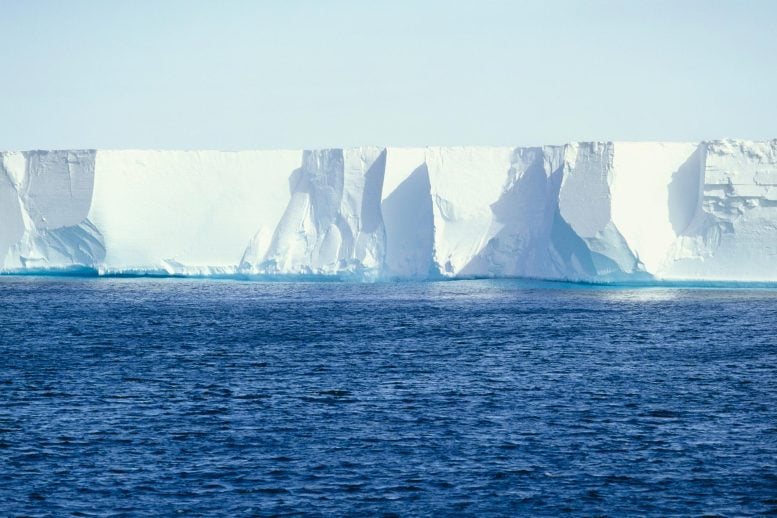By means of

Research from Washington University in St. Louis shows that the Ross Ice Shelf in Antarctica, about the size of France, is disrupted daily by an ice flow. This movement, caused by a sudden slip in the ice flow, could affect icequakes and ice shelf ruptures, raising concerns about the stability of ice shelves in a warming world.
Ice flow activity has caused the Ross Ice Shelf to suddenly move.
In Antarctica, huge glaciers are constantly moving. Ice streams, which act as conveyor belts, are the routes of accelerated motion that transport most of the ice and sediment debris from these vast glaciers to the ocean.
One such ice flow displaces the entire Ross Ice Shelf at least once a day, according to new research from Washington University in St. Louis.
This finding is significant because of the size of the Ross Ice Shelf: it is the largest ice shelf in Antarctica, about the size of the country of France.
“We found that once or twice a day, the entire shelf suddenly moves about 6 to 8 centimeters (or 3 inches), caused by a slip on an ice stream that flows into the ice shelf,” said Doug Wiens, director of Robert S. Brookings . Distinguished professor of earth, environmental and planetary sciences in the arts and sciences. “These sudden movements could potentially play a role in causing icequakes and faults in the ice shelf.”
The Ross Ice Shelf is a floating ice shelf that extends across the ocean from inland glaciers.
Scientists are interested in the interactions between ice shelves and ice streams in part because they worry about the stability of Antarctica’s ice shelves in a warming world.
Ice shelves act as a brake on glaciers and ice flows, slowing their journey to the sea where they melt, allowing more ice to accumulate on the continent. When an ice shelf collapses, this support disappears and the glaciers can flow faster. Once they flow into the ocean, they contribute to sea level rise.
The new study, published in the journal Geophysical research lettersfocuses on movement caused by the Whillans Ice Stream, one of about six large, fast-moving ice rivers flowing into the Ross Ice Shelf.
“You wouldn’t be able to detect the movement just by feeling it,” Wiens said. “The movement takes place over a period of several minutes and is therefore undetectable without instrumentation. That is why the movement has not been observed until now, even though people have been walking and camping on the Ross Ice Shelf since the time of the great explorers Robert F. Scott and Roald Amundsen.”
Slipping suddenly
The movement of the Ross Ice Shelf is caused by a relatively sudden – in glacial terms – movement of the ice flow, a so-called slip event. It is somewhat similar to the “stick-slip” that occurs along a fault line before and during an earthquake.
In the scenario that Wiens and his team observed, a large part of the Whillans ice flow, measuring more than 100 by 100 km, remains stationary while the rest of the ice flow creeps forward. Then, once or twice a day, the large section lurches forward against the Ross Ice Shelf.
It can move as much as 40 cm (16 inches) in a few minutes, Wiens said.
Research on ice flows over the past fifty years shows that some ice flows speed up and others slow down. Scientists can use seismographs to detect the sudden movement of the ice flows and help understand what controls this movement. Wiens and his team traveled to Antarctica in 2014 to install the seismographs used in this study.
“I have published several papers in the past on the slip events in the Whillans Ice Stream, but had not discovered until now that the entire Ross Ice Shelf is also moving,” Wiens said.
The researchers don’t think these slip events are directly related to human-induced global warming. One theory is that they are caused by the loss of water in the bottom of the Whillans Ice Stream, making it more ‘sticky’.
The stresses and strains associated with slip events are similar to the stresses and strains that cause icequakes under various conditions.
“Right now, icequakes and faults are just part of the normal lifespan of the ice shelf,” Wiens said. “There are concerns that the Ross Ice Shelf will one day break up, as other smaller and thinner ice shelves have done so too. We also know that the Ross Ice Shelf broke up during the last interglacial period – about 120,000 years ago – causing rapid ice loss to the other glaciers and ice streams flowing into it.”
Reference: “Ross Ice Shelf Displacement and Elastic Plate Waves Induced by Whillans Ice Stream Slip Events” by Douglas A. Wiens, Richard C. Aster, Andrew A. Nyblade, Peter D. Bromirski, Peter Gerstoft and Ralph A. Stephen, March 27 2024, Geophysical research letters.
DOI: 10.1029/2023GL108040